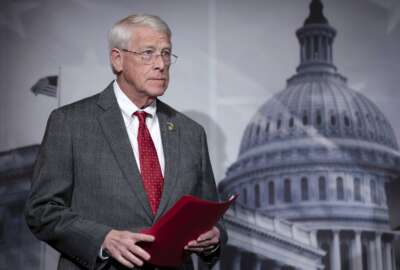DoD Cloud Exchange 2023: Defense’s Lily Zeleke on ‘rationalizing’ DoD’s troubled business systems landscape
From cloud computing contracts to Defense business systems, the DoD CIO’s office wants to help components retire technical debt, improve integration and reduce...
If you’re looking for a single word to encapsulate much of what Defense Department IT leaders are doing to modernize the department’s technology enterprise in 2023, “rationalization” might not be a bad choice. It’s happening both with respect to DoD’s portfolio of cloud computing contracts and with its sprawling collection of business systems.
The focus on business systems comes partly from the fact the Office of the Chief Information Officer inherited a wide range of oversight roles for those systems when Congress eliminated the position of chief management officer in 2021. The CIO organization now has more responsibility for business IT than it’s ever had.
Lily Zeleke, deputy DoD CIO for information enterprise, said the improvements she hopes to make aren’t focused just on more centralized supervision from the Pentagon but on finding ways to help DoD components that operate and use those systems finally retire their technical debt.
“There’s been enough oversight for Defense business systems. I don’t think the problem has been oversight,” she said during Federal News Network’s DoD Cloud Exchange 2023. “Over the years, we’ve focused on the process piece, but ultimately, you can’t improve process with legacy capabilities. So, the technology has to change. … The DoD CIO is responsible for coordinating and enabling, for example, a business enterprise architecture, working with all the functional communities. So the technical and the business have to marry up. And I think we’re in a position to ensure that that happens as we coordinate across the department.”
Gaining visibility across business operations
DoD’s efforts to modernize its business systems have been on the Government Accountability Office’s high-risk list since 1995. GAO says its main concerns are that the department lacks a governance structure to find and address duplication and overlap across those systems.
Zeleke said the CIO’s office is tackling that problem by improving the data in its Defense business systems repository so that the department has better visibility over not just what needs to be done to modernize those systems but which legacy systems should be shut down or consolidated.
“We’re already coming up with the technical criteria to address how we rationalize these systems — not just from a business standpoint but also how the technical pieces integrate into that so that we can make the tough decisions,” she said. “It will also help us make the decision to move the systems to the cloud if they can be moved to the cloud, which some can. So it is really a heavy lift that is going to require all of us in the department, from data, to business processes, to performance improvement, to having really good metrics that are output-driven. This is about the mission, the users and the warfighter we’re supporting. They’ve got to eat. They’ve got to get the things they need. They’ve got to get paid.”
Limiting cloud sprawl
When it comes to how the department buys cloud computing services, Zeleke said DoD sees its new Joint Warfighting Cloud Capability contracts as a rationalization opportunity as well. Although the department will not try to mandate a move to JWCC for the military services that have already created their own contract vehicles, DoD does want to limit sprawl and increase interoperability, she said.
“There’s a lot of optionality there that one or the other enterprise cloud [contracts] from the services may not offer. And when we think about something like Joint All Domain Command and Control (JADC2), it is really imperative that we’re all consistent in the way we acquire IT capabilities,” she said. “There may be things that the services have in place right now that help them optimize and they’re going continue to use. So we’re going to work with the services, and we will rationalize across the board as much as we can. We don’t want to duplicate the efforts, and we don’t want to have various cloud contracts popping up that we cannot track.”
DoD awarded JWCC contracts to Amazon Web Services, Google, Microsoft and Oracle in December. Zeleke said much of the work happening right now is focused on getting cloud services up and running at the secret and top-secret classification levels. Those classified, plus tactical edge capabilities are among the “unmet needs” the department has seen as requiring an enterprise approach like JWCC.
But DoD also wants to use the contract, managed by the Defense Information Systems Agency’s Hosting and Compute Center, to drastically simplify the process DoD components use to acquire cloud services.
“One of the major things the HACC is working on is to get the tools in place to speed up the ability to do the task orders,” Zeleke said. “They have two tools to automate the tracking and funding and ordering pieces. That’s to enable fast acquisitions, as well as to know our spending on cloud and optimize our services. It helps us get JWCC into use quicker. The differentiator is that for many of the processes where you would have paper or maybe different handoffs, it is now automated and in one place.”
To read or watch other sessions on demand, go to our 2023 DoD Cloud Exchange event page.
Copyright © 2024 Federal News Network. All rights reserved. This website is not intended for users located within the European Economic Area.
Related Stories
Featured speakers
-

Lily Zeleke
Deputy DoD CIO for Information Enterprise, DoD
-

Jared Serbu
Deputy Editor, DoD Reporter, Federal News Network
On DoD
Upcoming Events
Related Stories
Top Stories

Lily Zeleke
Deputy DoD CIO for Information Enterprise, DoD
Ms. Lily Zeleke is the Deputy CIO (DCIO) for the Information Enterprise (IE). In this role, she provides oversight, policy guidance, and digital expertise for DoD enterprise infrastructure initiatives driving toward the objectives of digital modernization. She leads Department-wide execution of strategic guidance aimed at achieving an operationally effective and secure Information Enterprise in a cost-efficient manner. Areas of priority include network optimization, cloud adoption, software modernization, and IT reform. She recently served as the Principal Director (PD) for the DCIO IE. Prior to these roles, Ms. Zeleke served as the Acting PD for the DCIO for Resources & Analysis (DCIO RA) as well as the Director of Resources, Program, and Budget. She was responsible for the management of DoD CIO’s processes for Planning, Programming, Budgeting, and Execution to include management of DoD CIO’s operating budget; the collection and submission of the DoD IT/Cyberspace Activities Budget to the Office of Management and Budget and Congress; execution of the DoD Budget Certification process; and DoD CIO’s participation in the Department’s Program Budget Review.
From 2009 to 2018, Ms. Zeleke served as the Department’s radiofrequency spectrum policy lead for all matters related to spectrum use, reallocation, and auction. In this capacity, she led the strategic development of the Department’s mobile broadband and domestic regulatory, policy, and legislative initiatives for the DCIO for Command, Control, and Communications (DCIO C3). She functioned as the liaison between DoD and spectrum stakeholders across the Department, national spectrum regulators, White House/Executive Branch agencies, and Congress, and spearheaded a wide range of complex initiatives to evolve traditional spectrum policies and practices to be more responsive to increased demand. She partnered with these stakeholders to forge an innovative solution that resulted in an amicable commercial auction decision of the highly sought 1755-1780 MHz band, expanding commercial Advanced Wireless Services (AWS-3) while preserving military capabilities. The auction brought in $44 billion to the U.S. Treasury and $3.1 billion for DoD. She led a coalition that developed a first-of-its-kind DoD spectrum efficiency principles policy memo, which became the cornerstone of the DoD 2020 Electromagnetic Spectrum Superiority Strategy.
Prior to joining DoD CIO, Ms. Zeleke served as the Deputy Technical Director and International Division Chief at the Air Force Frequency Management Agency where she advised on all matters concerning international telecommunications policy for spectrum use, and led Air Force participation in the International Telecommunications Union World Radiocommunication Conference (WRC), a global summit that reviews the international treaty governing the use of radiofrequency spectrum. Previously, she served as advisor to the Department of Commerce’s National Telecommunications and Information Administration and the Defense Information Systems Agency’s Defense Spectrum Organization on international spectrum regulatory policy, as well as a RF product support engineer at Allied Signal Inc.
Ms. Zeleke holds a M.S. in Systems Engineering from George Mason University and a B.S. in Electrical Engineering from the University of Kansas. She is a Senior Executive Fellow of the John F. Kennedy School of Government at Harvard University, and has been recognized on numerous occasions for her work including a National Intelligence Meritorious Unit Citation for her significant contribution to the success of the AWS-3 auction.
Ms. Zeleke is married and has one daughter. She believes a healthy work-life balance is critical to achieving effective productivity.

Jared Serbu
Deputy Editor, DoD Reporter, Federal News Network
Jared Serbu has been covering the Defense Department since 2010 and has filed hundreds of stories on DoD’s contracting, legislative, workforce and materiel issues. Jared has produced multiple news series, which included investigating DoD’s shrinking footprint and the Goldwater-Nichols Act: 25 years later. Jared also hosts On DoD, a weekly interview program with DoD officials.







